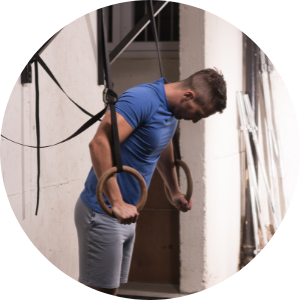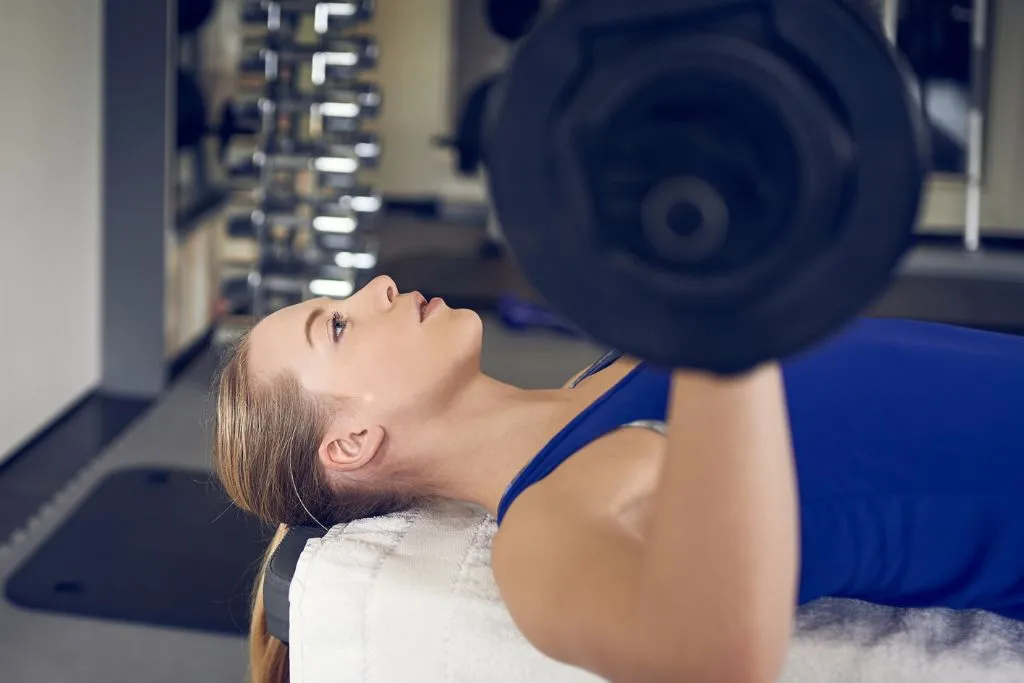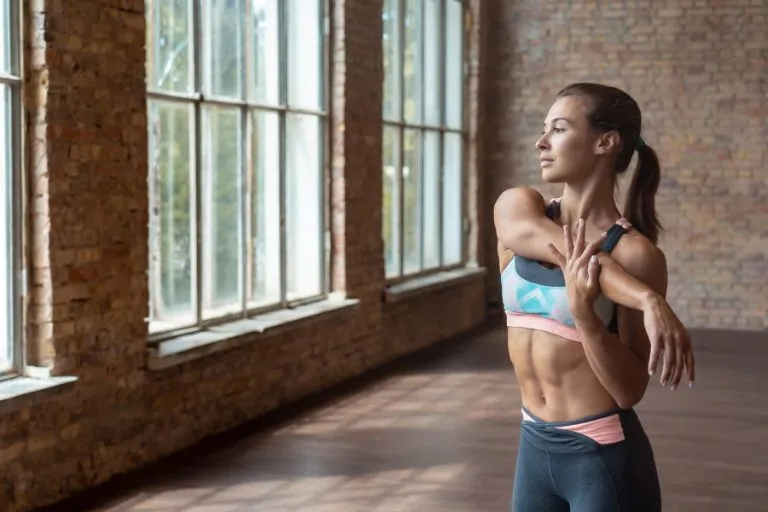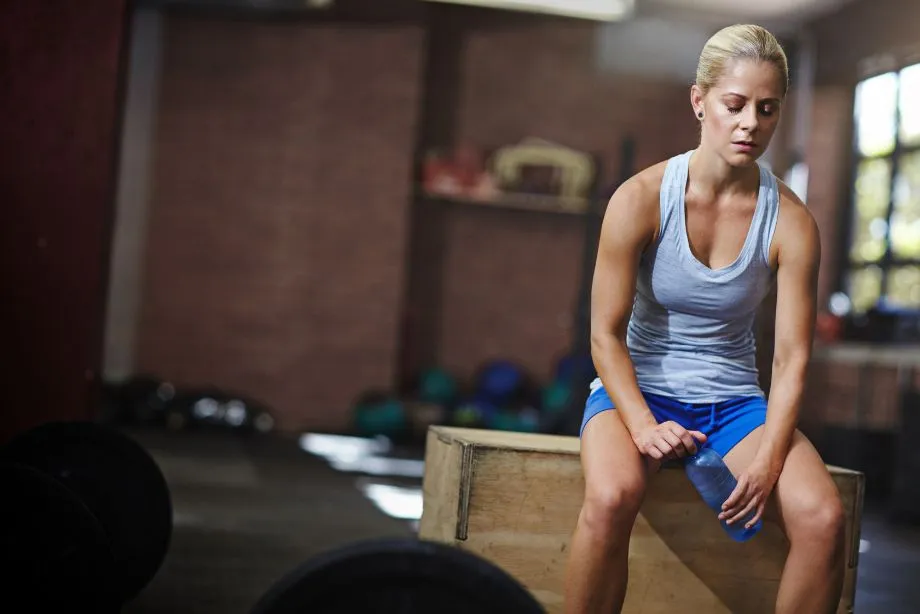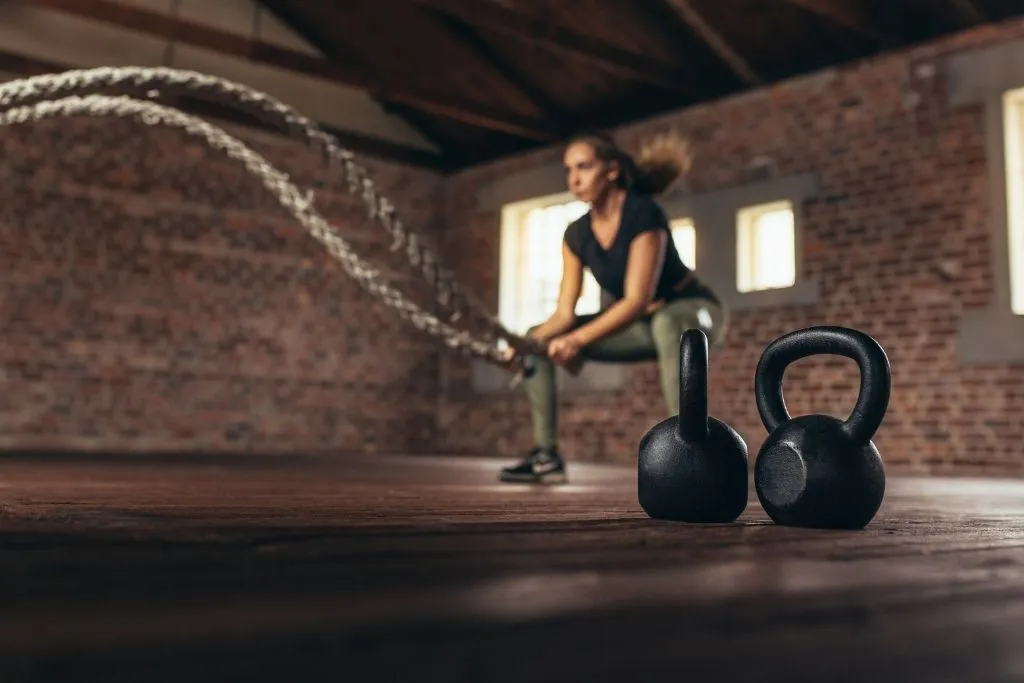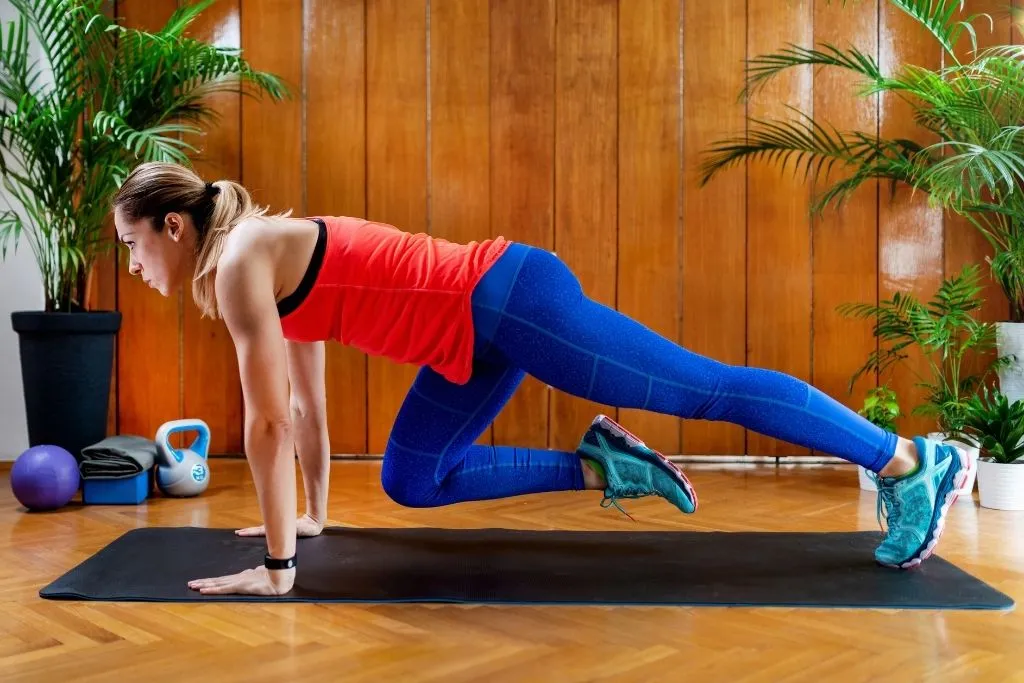Il existe des tonnes d’exercices différents pour cibler et tonifier le haut du corps. Et tous ceux qui ont déjà mis les pieds dans une salle de sport sauront que le développé couché en fait partie. C’est un exercice de base de la musculation qui cible principalement les muscles de la poitrine, les épaules et les triceps. C’est l’un des exercices les plus populaires car il peut être effectué de façons très diverses et il est relativement facile à apprendre. Dans cet article, nous allons discuter de la bonne façon de faire du développé couché et vous donner des conseils pour intégrer le développé couché dans votre programme.
Qu’est-ce que le développé couché ?
Le développé couché – ou Bench Press en anglais – est un exercice qui cible le haut du corps où vous vous allongez sur un banc avec les yeux sous la barre, placez vos mains sur la barre et « poussez » la barre au-dessus de votre poitrine. Vous pouvez également faire du développé couché avec des haltères et modifier l’inclinaison du banc, en positif ou en négatif.
Il est extrêmement populaire dans les salles de sport et vous trouverez plus rarement un poste de travail vide pour cet exercice que la cage à squat par exemple. C’est un exercice polyarticulaire qui est souvent pilier dans un programme d’entraînement car il permet de renforcer la poitrine, les épaules et les triceps.
Le développé couché peut être difficile, surtout si vous n’avez pas beaucoup de force dans le haut du corps, mais vous pouvez certainement y arriver avec les bons conseils et le bon programme. Il permet également de travailler la coordination intramusculaire et la stabilité du tronc.
Il existe également des compétitions spécifiques à ce mouvement et le développé couché est également pratiqué en Force Athlétique avec le Squat et le Soulevé de terre.

Pourquoi tout le monde devrait faire du développé couché ?
Premièrement, c’est un exercice de base pour développer les pectoraux, muscles principaux de votre poitrine. S’il est très populaire auprès des hommes, les femmes qui souhaitent travailler cette partie du corps spécifiquement ou renforcer leur posture devraient aussi y consacrer une place dans leur entraînement. S’agissant d’un mouvement polyarticulaire (l’opposé des exercices d’isolation), le développé couché est un exercice qui cible plusieurs muscles et articulations en un seul mouvement. Globalement, il va vous permettre de dépenser plus d’énergie en un temps de travail plus court.
Le développé couché cible principalement vos pectoraux, mais développe également votre deltoïde antérieur et vos triceps. Il peut être inclus dans un programme pour développer la force et la masse musculaire mais peut également contribuer à améliorer votre posture.
Comment faire un bon développé couché ?
Les entraînements du haut du corps peuvent être particulièrement difficiles pour les débutants surtout avec des charges lourdes. Si vous découvrez la musculation ou reprenez l’activité après une longue période, assurez-vous de commencer léger et de vous concentrer sur l’exécution du mouvement. Votre corps vous remerciera…
Le développé couché peut être effectué selon différentes techniques, mais la plus courante consiste à s’allonger sur le dos sur un banc, les pieds à plat sur le sol, et à tenir le poids au-dessus de soi, les mains rapprochées. Vous abaissez ensuite le poids sur votre poitrine et le remontez à la position de départ.
Avant de vous mettre au banc, assurez-vous d’avoir quelqu’un pour vous repérer, surtout lorsque vous soulevez des charges lourdes. Pendant les squats et les soulevés de terre, si la barre ou les poids libres tombent, ils atterriront sur le sol, mais avec un développé couché, vous aurez peut-être du mal à remettre la barre dans le rack, vous immobilisant efficacement sur le banc.
Le développé couché est un excellent exercice pour développer la force et la masse musculaire de la poitrine, des épaules et des triceps. Lorsqu’il est effectué correctement, il peut également contribuer à améliorer la posture. Voici quelques conseils sur la façon d’effectuer le développé couché de manière sûre et efficace :
- Placez une barre sur le support et ajoutez tout poids supplémentaire sous forme de plaques de poids. (Une fois que vous avez terminé votre One-Rep Max (1RM) dans l’application, vous recevrez des recommandations pour les poids.)
- Allongez-vous sur le banc de sorte que votre tête soit sous la barre.
- Plantez vos pieds sur le sol de chaque côté du banc ou sur le banc lui-même.
- Placez les deux mains sur la barre en pronation (paumes tournées vers vous), légèrement plus large que vos épaules. Poussez la barre loin de vous pour sortir la barre et étendez vos coudes pour tenir la barre directement devant votre poitrine. C’est votre position de départ.
- Pliez vos coudes pour abaisser la barre vers vous jusqu’à ce que la barre touche votre poitrine.
- Étendez vos coudes et poussez la barre loin de votre poitrine pour revenir à la position de départ. Répétez l’opération pour le nombre spécifié de répétitions avant de remettre la barre d’haltères dans une position sûre sur le rack.
Il est important de conserver une bonne technique lorsque vous effectuez le développé couché afin de protéger votre colonne vertébrale et d’éviter les blessures. Voici quelques conseils :
- Gardez votre dos fermement appuyé contre le banc, et ne le cambrez pas.
- Ne soulevez pas vos fesses du banc – restez en contact avec lui à tout moment.
- Gardez votre tête et votre cou dans le prolongement de votre colonne vertébrale et ne les laissez pas bouger d’un côté à l’autre.
- Ne laissez pas vos coudes s’écarter de votre corps – gardez-les près de vos côtés.
- Abaissez le poids lentement et de manière contrôlée.
Les variantes du développé couché
Il existe de nombreuses variantes du développé couché pour cibler différents muscles de la poitrine, ou pour travailler sur des objectifs spécifiques tels que l’augmentation de la force ou le développement de la définition musculaire.
Développé incliné
L’une des variantes les plus courantes du développé couché est le développé couché incliné, qui cible les muscles supérieurs de la poitrine. Pour réaliser cet exercice, commencez par vous allonger sur un banc incliné, le dos soutenu et les pieds à plat sur le sol. Ensuite, descendez la barre jusqu’à votre poitrine, faites une pause et remontez-la en position de départ.
Il existe de nombreuses autres variations du développé couché qui peuvent être effectuées pour cibler différents muscles ou atteindre des objectifs spécifiques. Quelle que soit la variante que vous choisissez, veillez à utiliser une forme et une technique appropriées pour éviter les blessures et tirer le meilleur parti de votre entraînement.

Développé couché prise serrée
Vous cherchez un entraînement ciblé des triceps ? Le développé couché à prise serrée est fait pour vous. Cet exercice peut être difficile, alors assurez-vous de commencer léger et de vous concentrer sur votre forme.
Dans un développé couché ordinaire, vos mains sont placées légèrement plus larges que vos épaules, mais dans un développé couché à prise serrée, vos mains doivent être écartées de la largeur des épaules. En rapprochant vos mains, vous déplacez l’accent de votre poitrine vers vos triceps.
Développé couché avec pause
Le développé couché avec pause fait passer votre entraînement d’un cran et augmente la force musculaire. Cette variation est particulièrement bonne si vous avez atteint un plateau et que vous souhaitez rendre votre développé couché plus difficile.
Le développé couché avec pause est effectué de la même manière qu’un développé couché classique, mais lorsque vous abaissez la barre vers votre poitrine, vous faites une pause de deux à trois secondes.
Développé couché avec haltères
Le développé couché peut également être effectué avec des haltères au lieu d’une barre. Cette variante s’appelle le développé couché avec haltères et peut être effectuée en s’asseyant sur un banc avec un haltère dans chaque main au niveau des épaules. Abaissez les haltères jusqu’à votre poitrine, faites une pause, puis remontez-les jusqu’à la position de départ .

Comment faire le développé couché en toute sécurité ?
Si vous êtes novice en matière de développé couché, il est toujours bon que quelqu’un vous observe. Cette personne peut vous aider avec le poids et s’assurer que vous utilisez la bonne forme. Lorsque vous faites du développé couché, assurez-vous de commencer avec un poids léger et d’augmenter progressivement la quantité de poids à mesure que vous vous renforcez. Il est également important d’utiliser une forme correcte en gardant le dos droit et en évitant de cambrer le bas du dos. N’oubliez pas de respirer tout au long de l’exercice et d’expirer lorsque vous soulevez les poids. Si vous ressentez une quelconque douleur, arrêtez l’exercice et consultez un médecin avant de continuer. Une mauvaise forme peut entraîner des blessures telles que des foulures, des entorses et des fractures.
Si vous avez des problèmes de santé, il est toujours bon d’en parler à votre médecin avant de commencer un nouveau programme d’exercices. Le développé couché peut être déconseillé aux personnes souffrant de certains problèmes de santé tels que les maladies cardiaques, l’hypertension artérielle ou les problèmes de dos.
Le développé couché est-il mauvais pour les épaules ?
Le développé couché est un exercice courant utilisé dans de nombreux programmes d’entraînement. Cependant, certaines personnes pensent que le développé couché peut être mauvais pour les épaules. En effet, le développé couché peut exercer une pression importante sur l’articulation de l’épaule.Le développé couché est un exercice composé qui fait travailler la poitrine, les épaules et les triceps. Le développé couché est un exercice très efficace pour développer la force du haut du corps. Cependant, si vous souffrez de douleurs aux épaules, il est préférable d’éviter le développé couché.
Si vous recherchez un exercice pour développer la force du haut du corps sans exercer de pression sur l’articulation de l’épaule, il existe de nombreuses options disponibles. Parmi les bonnes alternatives au développé couché, citons les pompes, les tractions et les presses à haltères. Ces exercices peuvent tous être effectués avec un risque faible ou nul de blesser les épaules.
Quand ajouter le développé couché à votre programme d’entraînement ?
Le développé couché est un excellent exercice à ajouter à votre programme d’entraînement musculaire. Vous pouvez le faire 2 à 3 fois par semaine, les jours où vous ne faites pas d’autres activités fatigantes. Au début, commencez par des poids légers et augmentez progressivement la quantité de poids que vous soulevez à mesure que vous vous renforcez. Si vous êtes novice en matière d’entraînement musculaire, il est toujours bon de consulter un entraîneur personnel certifié ou un coach pour apprendre la forme et la technique appropriées avant d’ajouter le développé couché à votre programme d’entraînement
Lorsque vous faites du développé couché, il est important d’utiliser un poids qui soit stimulant mais pas trop lourd. Vous devez être capable d’effectuer 8 à 12 répétitions avec une bonne forme avant d’augmenter le poids. Comme comme tout autre exercice, le développé couché peut être dangereux s’il n’est pas effectué correctement. Veillez à utiliser une forme et une technique appropriées et consultez toujours un entraîneur personnel certifié ou un coach si vous êtes novice en matière de musculation. Une forme incorrecte peut entraîner des blessures telles que des entorses, des foulures et des fractures.
Si vous souffrez de problèmes de santé, il est toujours bon d’en parler à votre médecin avant de commencer un nouveau programme d’exercices. Le développé couché peut être déconseillé aux personnes souffrant de certains problèmes de santé tels que les maladies cardiaques, l’hypertension artérielle ou les problèmes de dos.

Conclusion
Le développé couché est un excellent exercice pour la force et le développement global du haut du corps. Il cible principalement les muscles de la poitrine, mais fait également travailler les épaules, les triceps et les biceps. Voici quelques conseils sur la façon de faire des développés couchés en toute sécurité et efficacement. Lorsque vous commencez, veillez à utiliser un poids qui soit stimulant mais pas trop lourd. Vous devez être capable d’effectuer 8 à 12 répétitions avec une bonne forme avant d’augmenter le poids. N’oubliez pas d’inspirer tout au long de l’exercice et d’expirer lorsque vous soulevez les poids. Si vous ressentez une quelconque douleur, arrêtez l’exercice et consultez un médecin avant de continuer. Une mauvaise forme peut entraîner des blessures telles que des foulures, des entorses et des fractures. Faites-vous toujours surveiller par quelqu’un lorsque vous faites du développé couché, au cas où vous auriez besoin d’aide avec le poids ou de corrections
L'expert Fitness pour Oktofit :
